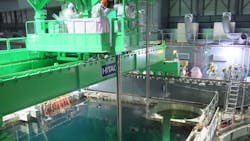Fukushima Dumps First Batch of Once-Radioactive Water
TOKYO — Japan’s crippled Fukushima nuclear plant began releasing previously contaminated water into the sea on Monday, but the man tasked with preventing another meltdown warned other highly radioactive fluid still stored on site could pose a major threat.
Tokyo Electric Power Co (TEPCO), which operates the plant in eastern Japan, discharged 850 tons of formerly contaminated water it had extracted from the ground near the plant into the sea, saying a filtration process had now made it safe.
Monday was the first time the plant, whose reactors went into meltdown after being hit by a huge tsunami in 2011, has released once-radioactive water into nature after a years-long battle with fishermen, who feared it could destroy their livelihood.
But Dale Klein, the chairman of a committee created to ensure the nuclear meltdown is never repeated, said other highly radioactive water used to cool the reactors four years ago — and which is still kept in tanks in the plant — could be dangerous.
“The risk that you run is that you have all these tanks full of water,” Klein told AFP in an interview. “The longer you store the water, the more likely you are going to have (an) uncontrolled release,” he said, adding that he would like to see the supplies released from storage in the next three years.
TEPCO has faced criticism for its handling of the meltdown, which saw thousands of people evacuated as radiation poisoned the air, land and water and has already cost some $57 billion in compensation for residents.
Four years later, it is still extracting some 300 tons of contaminated water from the ground every day, which had been stored in tanks before TEPCO started releasing it into the sea after purification on Monday.
‘Long-Term Solution’
The move is a milestone for the company, which said its Advanced Liquid Processing System, which removes highly radioactive substances like strontium and cesium, meant the ground water was now safe to release into the natural environment.
Fishermen had argued that the discharge even of the groundwater would heighten contamination concerns and hurt their already-battered reputation. They had fought to stop the water being released into the sea, even after it is filtered, but eventually bowed to pressure from TEPCO, which is struggling to find space to store the tainted supplies.
But it has yet to find a solution to deal with another highly radioactive 680,000 tons of water that was used to cool the reactors during the meltdown, which is still stored on site.
Fishermen are opposed to the fluid being released into the sea, even after it is filtered.
“I would much rather see Japan move to a long-term solution of the controlled release, rather than have an unexpected release” that could be caused by pipe breaks or other failures, Klein said.
Torrential flooding this month in an area not far south of the plant added to contamination concerns, flushing away at least 293 plastic bags of plants and soil that had been collected in the clean-up.
The tsunami, following a 9.0 magnitude quake, triggered the world’s worst nuclear disaster in a generation and prompted Tokyo to shut down the 50 reactors nationwide used to generate electricity.
This month saw the evacuation order lifted for Naraha, the first of seven municipalities fully emptied after the explosion whose residents can return permanently, but the full clean-up is expected take decades.
By Harumi Ozawa
Copyright Agence France-Presse, 2015
About the Author
Agence France-Presse
Copyright Agence France-Presse, 2002-2025. AFP text, photos, graphics and logos shall not be reproduced, published, broadcast, rewritten for broadcast or publication or redistributed directly or indirectly in any medium. AFP shall not be held liable for any delays, inaccuracies, errors or omissions in any AFP content, or for any actions taken in consequence.
